An Investigation into the Variables Influencing the Structural Bamboo Architecture Using Filled Concrete and Cement Mortar
Abstract
:1. Introduction
2. Materials and Methods
2.1. Materials
2.1.1. Physical and Mechanical Properties of Bamboo Elements
2.1.2. Concrete Properties
2.1.3. Cement Mortar Properties
2.1.4. Steel Properties
2.2. Methods
2.2.1. Finite Element Modeling
2.2.2. Test
2.2.3. Structural Bamboo Filled with Concrete
2.2.4. Test Setup and Instrumentation Layout
3. Results
3.1. Test Results of BFC Columns
Overall Observations and Failure Modes
3.2. Ultimate Capacity and Peak Strain
3.3. Axial Load–Strain Behavior
3.3.1. Hollow Bamboo Specimens
3.3.2. Solid BFC Specimens
3.4. Model Validation
4. Discussion
4.1. Mathematical Model of BFC Columns
4.2. Formula of the Ultimate Bearing Capacity of BFC Columns
4.3. Impact of BFC on Bamboo Architecture
Analysis of the Program’s Viability
5. Conclusions
Supplementary Materials
Author Contributions
Funding
Data Availability Statement
Conflicts of Interest
Appendix A
References
- Escamilla, E.Z.; Habert, G.; Daza, J.F.C.; Archilla, H.F.; Fernández, J.S.E.; Trujillo, D. Industrial or traditional bamboo construction? Comparative life cycle assessment (LCA) of bamboo-based buildings. Sustainability 2018, 10, 3096. [Google Scholar] [CrossRef]
- Lou, Z.; Wang, Q.; Sun, W.; Zhao, Y.; Wang, X.; Liu, X.; Li, Y. Bamboo flattening technique: A literature and patent review. Eur. J. Wood Prod. 2021, 79, 1035–1048. [Google Scholar] [CrossRef]
- Lou, Z.; Yuan, T.; Wang, Q.; Wu, X.; Hu, S.; Hao, X.; Liu, X.; Li, Y. Fabrication of crack-free flattened bamboo and its macro-/micro morphological and mechanical properties. J. Renew. Mater. 2021, 9, 959–977. [Google Scholar] [CrossRef]
- Lou, Z.; Han, X.; Liu, J.; Ma, Q.; Yan, H.; Yuan, C.; Yang, L.; Han, H.; Weng, F.; Li, Y. Nano-Fe3O4/bamboo bundles/phenolic resinoriented recombination ternary composite with enhanced multiple functions. Compos Pt. B Eng. 2021, 226, 109335. [Google Scholar] [CrossRef]
- Lou, Z.; Wang, Q.; Kara, U.I.; Mamtani, R.S.; Zhou, X.; Bian, H.; Yang, Z.; Li, Y.; Lv, H.; Adera, S.; et al. Biomass-derived carbon heterostructures enable environmentally adaptive wideband electromagnetic wave absorbers. Nano-Micro Lett. 2022, 4, 11. [Google Scholar] [CrossRef] [PubMed]
- Chen, C.; Li, Z.; Mi, R.; Dai, J.; Xie, H.; Pei, Y.; Li, J.; Qiao, H.; Tang, H.; Yang, B.; et al. Rapid processing of whole bamboo with exposed, aligned nanofibrils toward a high-performance structural material. ACS Nano 2020, 14, 5194–5202. [Google Scholar] [CrossRef] [PubMed]
- Sanchez, C.H.; Arribart, M.G.; Guile, M.G. Biomimetism and bioinspiration as tools for the design of innovative materials and systems. Nat. Mater. 2005, 4, 277–288. [Google Scholar] [CrossRef] [PubMed]
- Zhang, Y. Mechanical characteristics of tensile strength for three monopodial bamboo single roots. Sci. Silvae Sin. 2013, 49, 183–187. [Google Scholar] [CrossRef]
- Li, Z.; Chen, C.; Mi, R.; Gan, W.; Dai, J.; Jiao, M.; Xie, H.; Yao, Y.; Xiao, S.; Hu, L. A strong, tough, and scalable structural material from fast-rowing bamboo. Adv. Mater. 2020, 32, 1906308. [Google Scholar] [CrossRef]
- Lu, K. The future of metals. Science 2020, 328, 319–320. [Google Scholar] [CrossRef] [PubMed]
- Bouville, F.; Maire, E.; Meille, S.; Van de Moortèle, B.; Stevenson, A.J.; Deville, S. Strong, tough and stiff bioinspired ceramics from brittle constituents. Nat. Mater. 2014, 13, 508–514. [Google Scholar] [CrossRef]
- Song, J.; Chen, C.; Zhu, S.; Zhu, M.; Dai, J.; Ray, U.; Li, Y.; Kuang, Y.; Li, Y.; Quispe, N.; et al. Processing bulk natural wood into a high-performance structural material. Nature 2018, 554, 224–228. [Google Scholar] [CrossRef] [PubMed]
- Mittal, N.; Ansari, F.; Gowda, V.K.; Brouzet, C.; Chen, P.; Larsson, P.T.; Roth, S.; Lundell, F.; Wågberg, L.; Kotov, N.A.; et al. Multiscale control of nanocellulose assembly: Transferring remarkable nanoscale fibril mechanics to macroscale fibers. Acs Nano 2018, 12, 6378–6388. [Google Scholar] [CrossRef] [PubMed]
- Xia, M.; Sanjayan, J. Method of formulating geopolymer for 3d printing for construction applications. Mater. Des. 2016, 110, 382–390. [Google Scholar] [CrossRef]
- Wegst, U.G.; Bai, H.; Saiz, E.; Tomsia, A.P.; Ritchie, R.O. Bioinspired structural materials. Nat. Mater. 2015, 14, 23–26. [Google Scholar] [CrossRef] [PubMed]
- Wang, Y.Y.; Wang, X.Q.; Li, Y.Q.; Huang, P.; Yang, B.; Hu, N.; Fu, S.Y. High-performance bamboo steel derived from natural bamboo. ACS Appl. Mater. Interfaces 2021, 13, 1431–1440. [Google Scholar] [CrossRef] [PubMed]
- Yang, Y.K. Strengthening and toughening of a 2800-MPa grade maraging steel. Mater. Lett. 2020, 56, 763–769. [Google Scholar] [CrossRef]
- Sun, Q.F. Inspiration given by nature: A brief discussion on wood bionics. China Chem. Eng. Sci. 2014, 16, 4–12+2. [Google Scholar]
- Sun, J.; Wang, W.; Song, Y. Tectonic Finish Control. New Archit. 2021, 34–37. [Google Scholar]
- Bala, A.; Gupta, S. Engineered bamboo and bamboo-reinforced concrete elements as sustainable building materials: A review. Constr. Build. Mater. 2023, 394, 132116. [Google Scholar] [CrossRef]
- Zhao, Y.; Huang, Y.; Gao, X. A Study on the Design Methods and Technical Strategies of Bamboo Architecture by Wu Chongyi. Archit. J. 2024, 70–77. [Google Scholar] [CrossRef]
- Li, W.T.; Long, Y.L.; Huang, J.; Lin, Y. Axial load behavior of structural bamboo filled with concrete and cement mortar. Constr. Build. Mater. 2017, 148, 273–287. [Google Scholar] [CrossRef]
- Yu, T.; Teng, J.G.; Wong, Y.L.; Dong, S.L. Finite element modeling of confined concrete-II: Plastic-damage model. Eng. Struct. 2010, 32, 680–691. [Google Scholar] [CrossRef]
- Teng, J.G.; Xiao, Q.G.; Yu, T.; Lam, L. Three-dimensional finite element analysis of reinforced concrete columns with FRP and/or steel confinement. Eng. Struct. 2015, 97, 15–28. [Google Scholar] [CrossRef]
- GB 50010-2010; Code for Design of Concrete Structures. China Architecture and Building Press: Beijing, China, 2010.
- Candappa, D.C.; Sanjayan, J.G.; Setunge, S. Complete triaxial stress-strain curves of high-strength concrete. J. Mater. Civ. Eng. 2001, 13, 209–215. [Google Scholar] [CrossRef]
- Wang, Y.; Yang, L.; Yang, H.; Liu, C. Behaviour of concrete-filled corrugated steel tubes under axial compression. Eng. Struct. 2019, 183, 475–495. [Google Scholar] [CrossRef]
- Yuan, S. The Research on The Constitutive Model and Size Effect Law of Masonry Mortar; Changsha University of Science Technology: Changsha, China, 2019. [Google Scholar]
- Liu, J.P.; Zhou, X.H.; Gan, D. Effect of friction on axially loaded stub circular tubed columns. Adv. Struct. Eng. 2016, 19, 546–559. [Google Scholar] [CrossRef]
- Tao, Z.; Wang, Z.B.; Yu, Q. Finite element modelling of concrete-filled steel stub columns under axial compression. J. Constr. Steel Res. 2013, 89, 121–131. [Google Scholar] [CrossRef]
- Tang, M.; Yi, W.J.; Chen, H.; Wu, Y.F. Numerical and analytical investigation on the moment and deformation capacity of interior slab-column connections without shear reinforcement. Adv. Struct. Eng. 2021, 24, 3707–3723. [Google Scholar] [CrossRef]
- Lawson, R.M.; Ogden, R.G.; Bergin, R. Application of modular construction in highrise buildings. J. Archit. Eng. 2012, 18, 148–154. [Google Scholar] [CrossRef]
- Lima, H.C.; Willrich, F.L.; Barbosa, N.P.; Rosa, M.A.; Cunha, B.S. Durability analysis of bamboo as concrete reinforcement. Mater. Struct. 2008, 41, 981–989. [Google Scholar] [CrossRef]
- Yu, M.; Zha, X.X.; Ye, J.Q.; She, C.Y. A unified formulation for hollow and solid concrete-filled steel tube columns under axial compression. Eng. Struct. 2010, 32, 1046–1053. [Google Scholar] [CrossRef]
- Vaessen, M.J.; Janssen, J.J.A. Analysis of the critical length of culms of bamboo in four-point bending tests. Heron 1997, 42, 113–124. [Google Scholar]
- Sadd, M.H. Elasticity: Theory, Applications and Numerics; Academic Press: Cambridge, MA, USA, 2014. [Google Scholar]
- Li, W.; Zha, X.; Wang, H. A unified formulation for axial compression of steel tube-confined concrete and concrete-filled steel tube stub columns. Structures 2023, 58, 105319. [Google Scholar] [CrossRef]

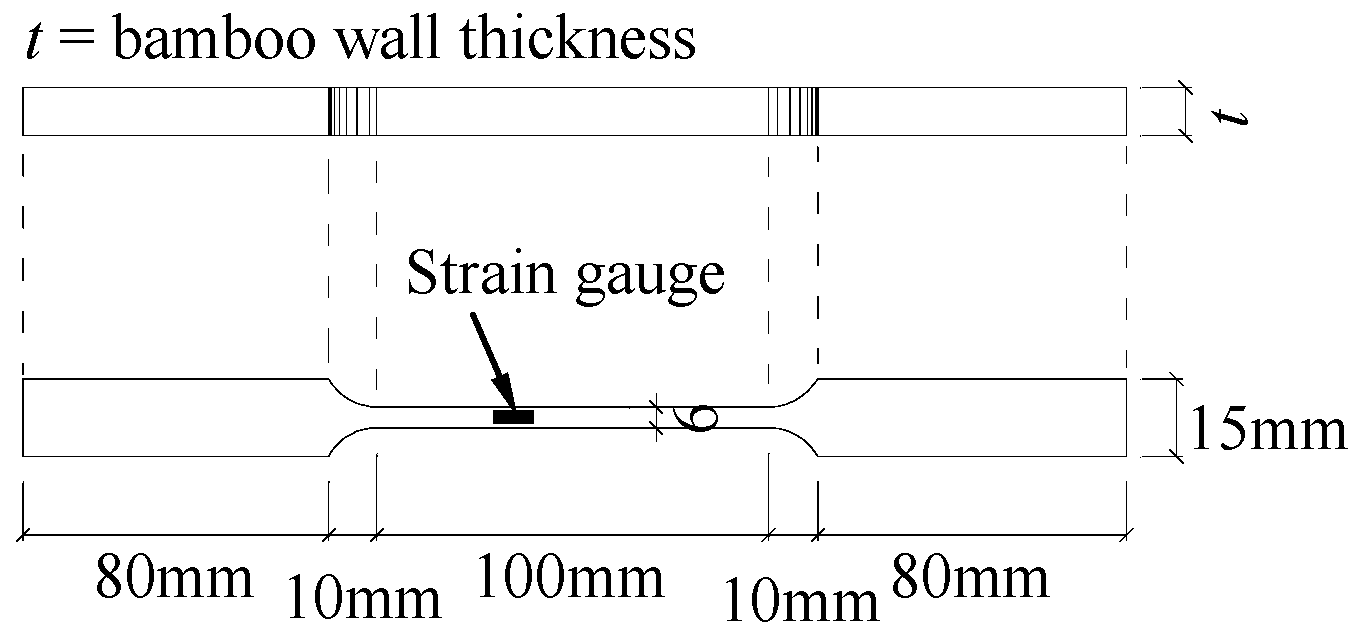
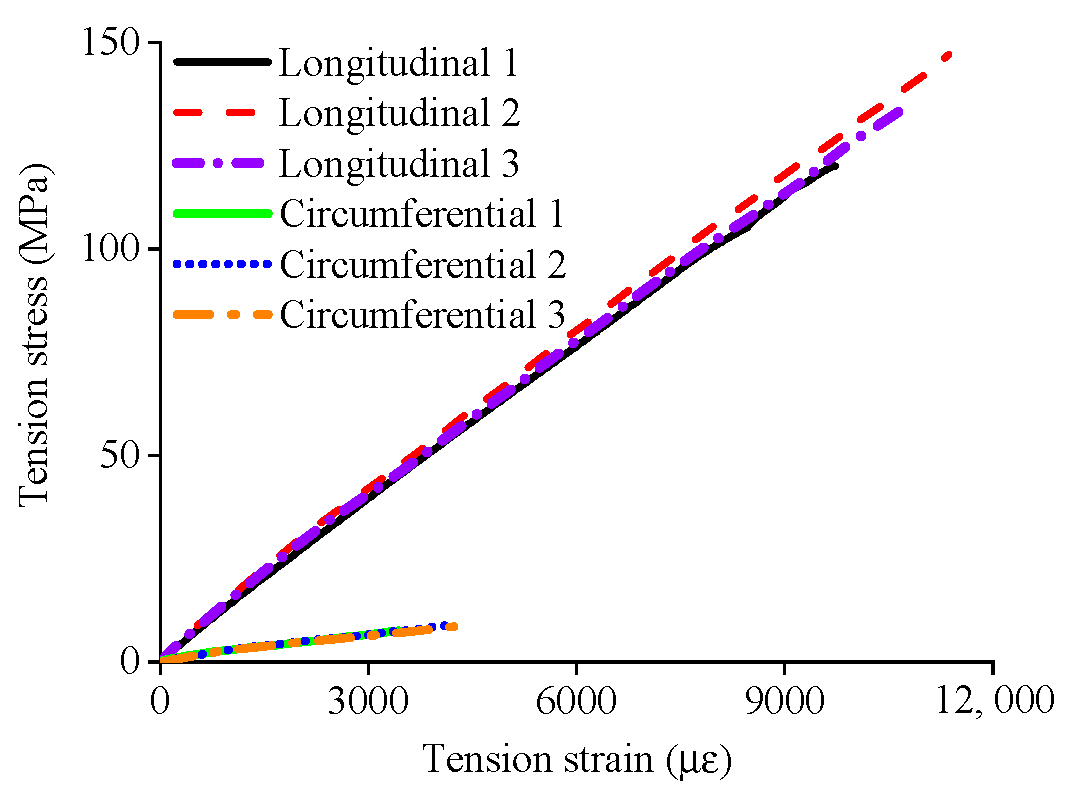





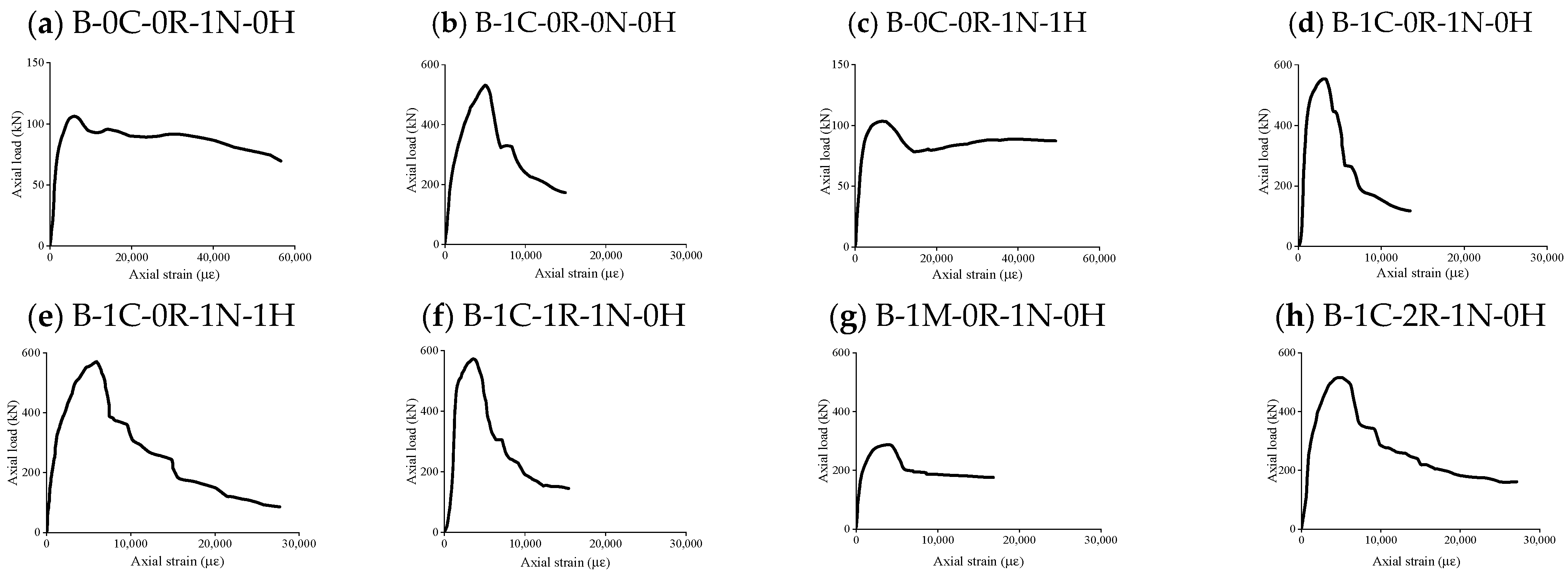

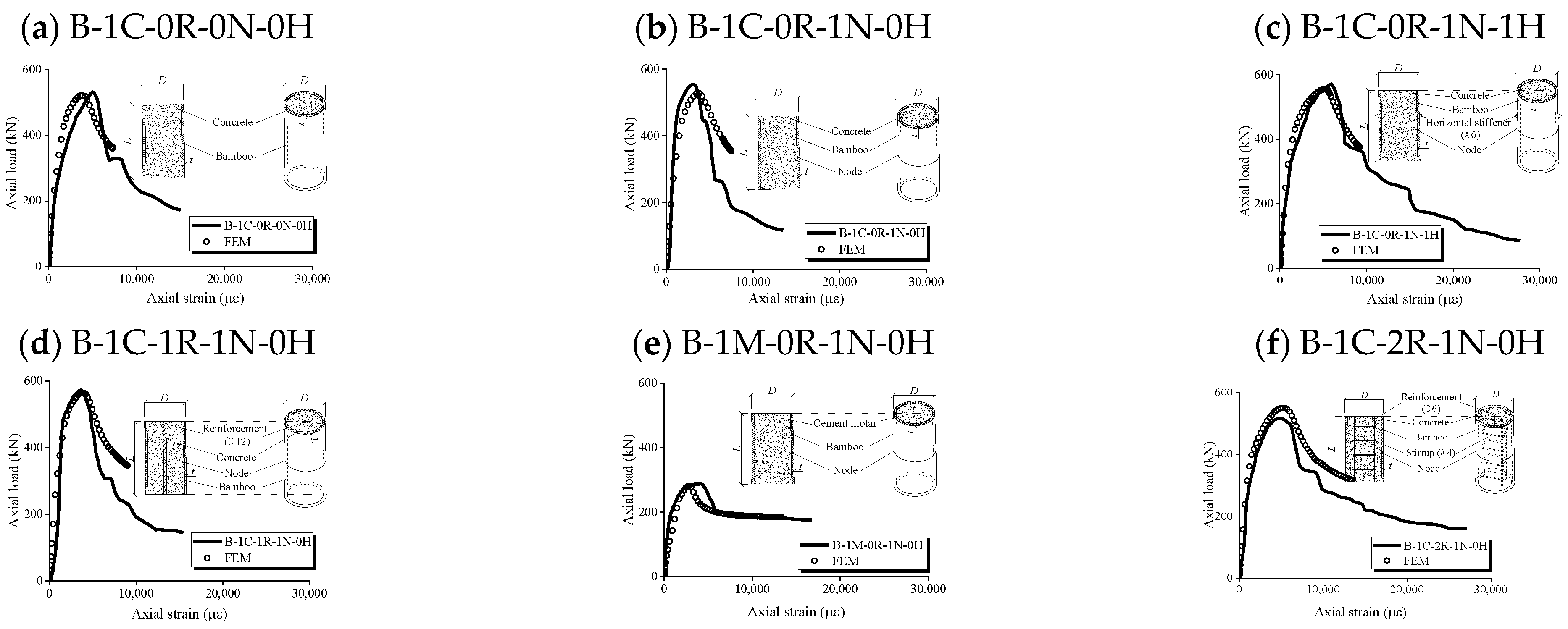


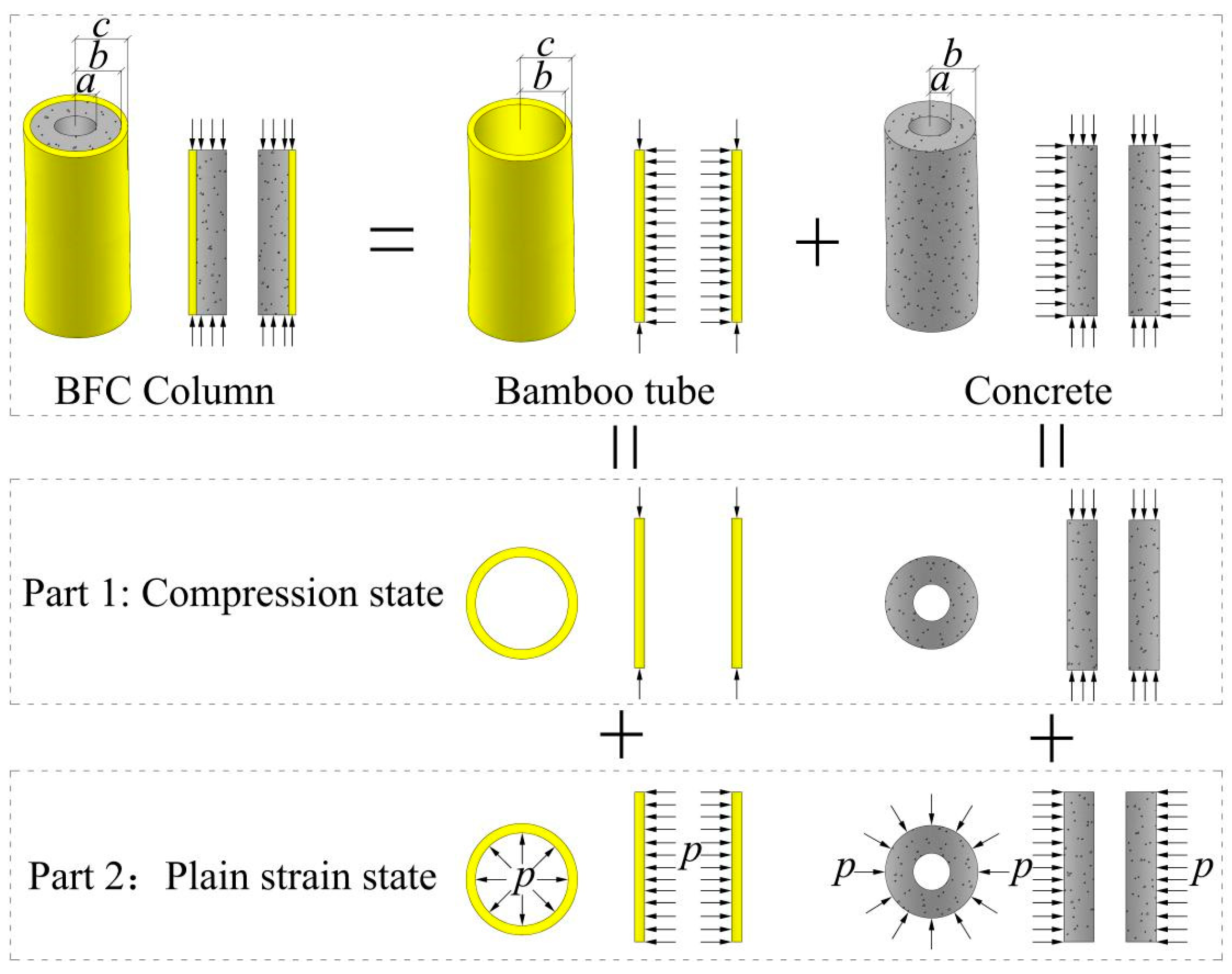
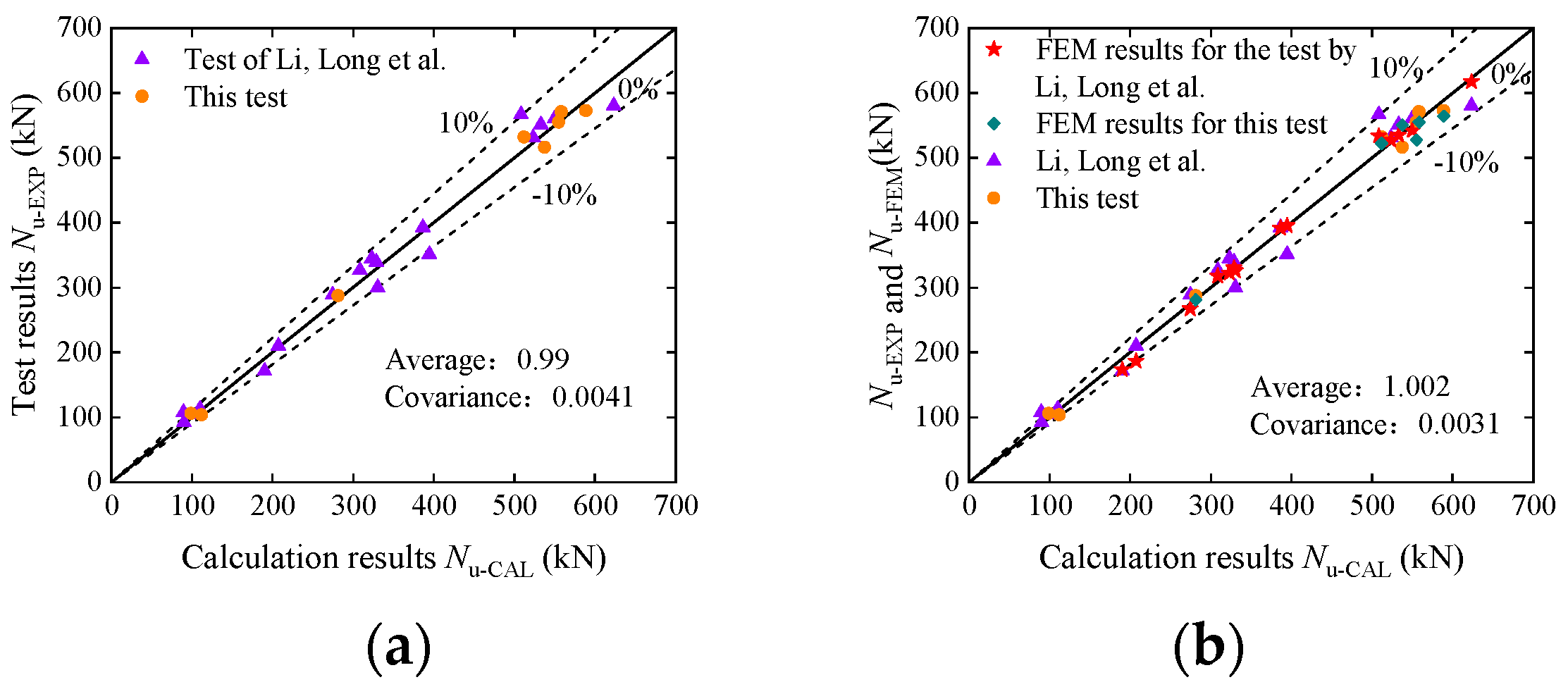



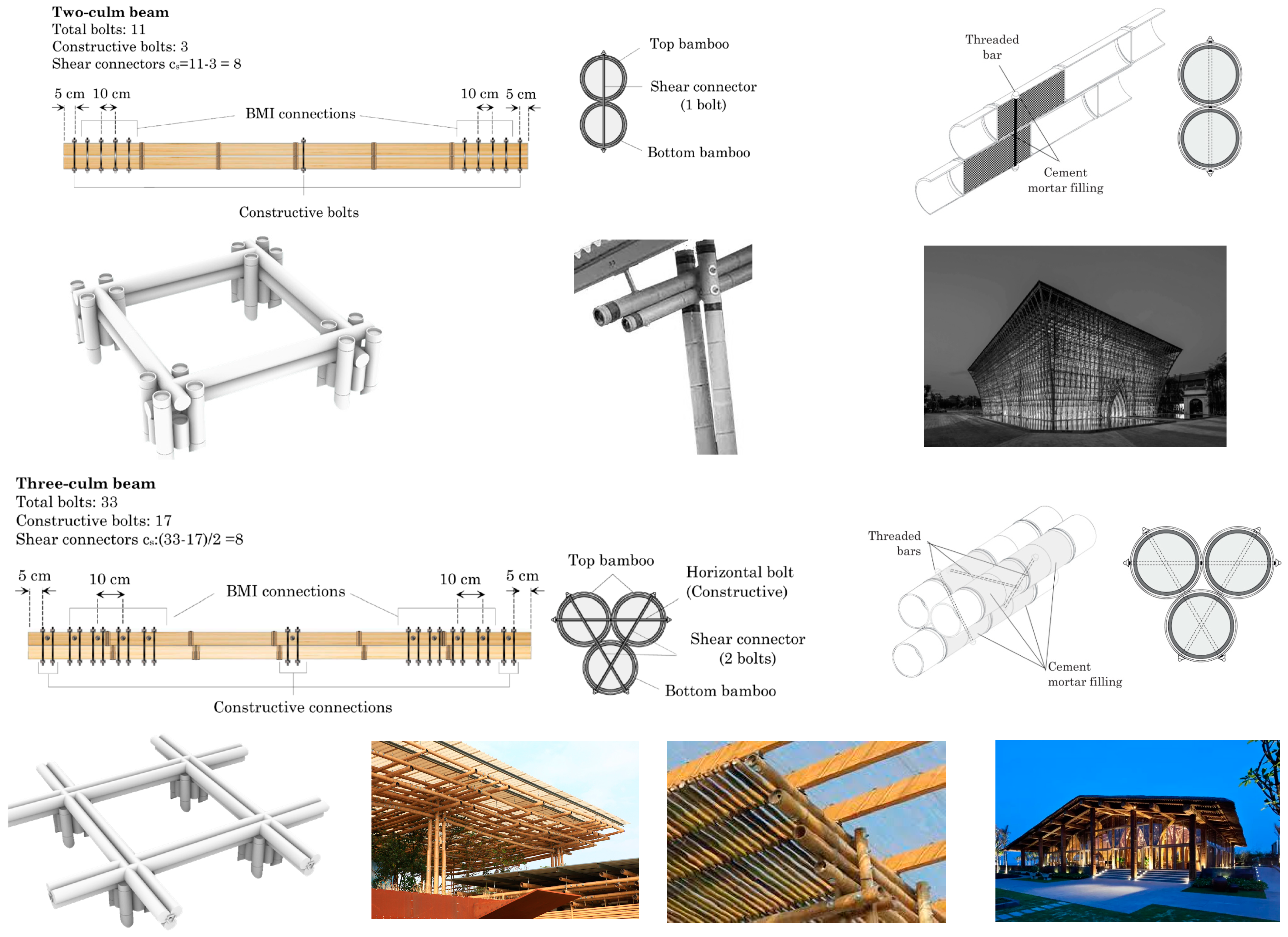
| Physical properties (standard) | |||||
| Density | Moisture | Water adsorption | Shrinkage | Hardness | Thermal conductivity |
| ASTM-D143 | ISO 8302-1991 | ||||
| ASTM-D2395 | BSEN 408 | ASTM-D1037 | ASTM-D143 | ASTM-D143 | ISO 8990-1994(E) |
| Mechanical properties (standard) | |||||
| Standard | Compression | Tension | Shear | Bending | |
| BS 373 | ASTM D143 | BS 373 | BS EN408 | ||
| D143 | ASTM D143-09 | D143 1 | D143 | ||
| ASTM D143-09 | ASTM D143-94 | ASTM D-1037 | |||
| ASTM D2344 | GB/T50329-2012 | ||||
| JAS 1587 | |||||
| Bamboo | ||||||
| Moisture (%) | Density (KG/M3) | Axial tensile strength (MPa) | Axial elastic (GPa) | Compressive strength (MPa) | ||
| 9.0 | 686.0 | 100–400 | 5–25 | 45–65 | ||
| Bamboo tube | ||||||
| Compression (MPa) | Elastoplastic (GPa) | Elastic (GPa) | Poisson’s ratio | Stress (MPa) | ||
| Parallel | Axial | |||||
| 24.76 | 13.70 | 2.11 | 13.70 | 0.30 | 8..36 | |
| Specimen | L (mm) | D (mm) | t (mm) | D/t | Material Infilled | Node | Stiffener | Reinforcement |
|---|---|---|---|---|---|---|---|---|
| B-0C-0R-1N-0H | 297 | 131 | 11 | 11.9 | With | Without | ||
| B-1C-0R-0N-0H | 296 | 135 | 11 | 12.3 | Concrete | Without | Without | |
| B-0C-0R-1N-1H | 294 | 138 | 11.1 | 12.4 | With | With | ||
| B-1C-0R-1N-0H | 300 | 138 | 11.4 | 12.1 | Concrete | With | Without | |
| B-1C-0R-1N-1H | 302 | 139 | 10.5 | 13.2 | Concrete | With | With | |
| B-1C-1R-1N-0H | 290 | 141 | 12.6 | 11.4 | Concrete | With | Without | 1 A12 |
| B-1M-0R-1N-0H | 300 | 136 | 12.3 | 11.0 | Cement mortar | With | Without | |
| B-1C-2R-1N-0H | 293 | 133 | 10.9 | 12.2 | Concrete | With | Without | 4 C 6 + A 4@50 |
| Specimen | εcc-EXP | (kN) | (N/mm2) | (kN) | |||
|---|---|---|---|---|---|---|---|
| B-0C-0R-1N-0H | 0.00588 | 106.21 | 1.00 | 26.6 | 98.97 | 0.93 | ___ |
| B-1C-0R-0N-0H | 0.00498 | 531.95 | 5.01 | 37.08 | 511.82 | 0.96 | 2.37 |
| B-0C-0R-1N-1H | 0.00629 | 103.68 | 0.98 | 22.94 | 111.91 | 1.08 | ___ |
| B-1C-0R-1N-0H | 0.00314 | 554.83 | 5.22 | 37.16 | 554.81 | 1.00 | 1.50 |
| B-1C-0R-1N-1H | 0.00591 | 571.03 | 5.38 | 37.40 | 558.16 | 0.98 | 2.81 |
| B-1C-1R-1N-0H | 0.00367 | 572.36 | 5.39 | 36.86 | 588.71 | 1.03 | 1.75 |
| B-1M-0R-1N-0H | 0.00378 | 287.53 | 2.71 | 19.81 | 281.29 | 0.98 | 1.63 |
| B-1C-2R-1N-0H | 0.00512 | 516.11 | 4.86 | 37.13 | 537.31 | 1.04 | 2.44 |
| Mean | 0.99 | ||||||
| COV | 0.0020 |
Disclaimer/Publisher’s Note: The statements, opinions and data contained in all publications are solely those of the individual author(s) and contributor(s) and not of MDPI and/or the editor(s). MDPI and/or the editor(s) disclaim responsibility for any injury to people or property resulting from any ideas, methods, instructions or products referred to in the content. |
© 2024 by the authors. Licensee MDPI, Basel, Switzerland. This article is an open access article distributed under the terms and conditions of the Creative Commons Attribution (CC BY) license (https://creativecommons.org/licenses/by/4.0/).
Share and Cite
Huang, J.; Liu, X.; Long, Y.; Li, W.; Wu, R. An Investigation into the Variables Influencing the Structural Bamboo Architecture Using Filled Concrete and Cement Mortar. Buildings 2024, 14, 2029. https://doi.org/10.3390/buildings14072029
Huang J, Liu X, Long Y, Li W, Wu R. An Investigation into the Variables Influencing the Structural Bamboo Architecture Using Filled Concrete and Cement Mortar. Buildings. 2024; 14(7):2029. https://doi.org/10.3390/buildings14072029
Chicago/Turabian StyleHuang, Jun, Xiaojuan Liu, Yueling Long, Wentao Li, and Ruoyue Wu. 2024. "An Investigation into the Variables Influencing the Structural Bamboo Architecture Using Filled Concrete and Cement Mortar" Buildings 14, no. 7: 2029. https://doi.org/10.3390/buildings14072029




